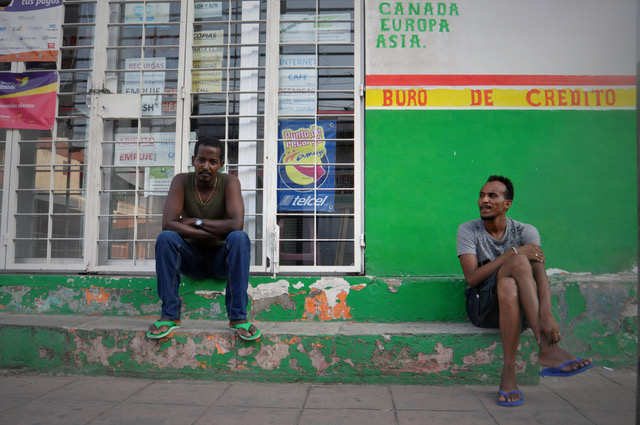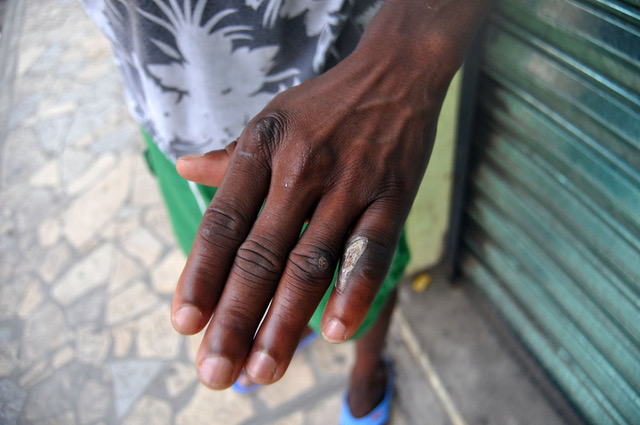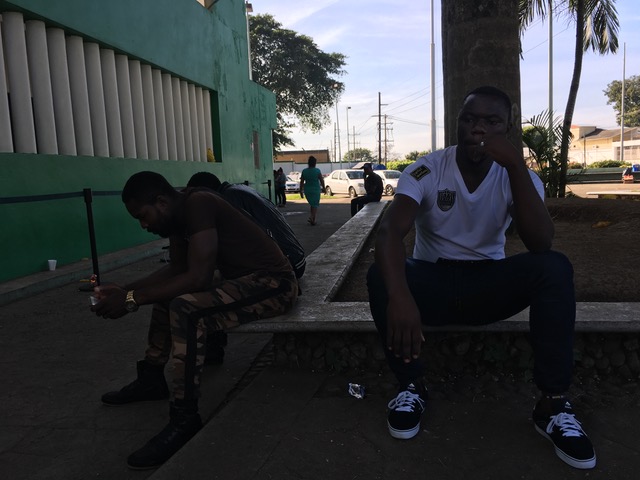TAPACHULA, Mexico – In the Mexican border town of Tapachula, near the Guatemalan border, a 27-year-old Somali man made inquiries at a grotty inn called the Imperial Hotel. He had arrived in Mexico a day earlier.
Nadir C. fled Somalia several years ago after falling in love with a woman from a rival tribe. Pursued by her family, he escaped to Kenya, before traveling on to Uganda and South Sudan.
There he met a smuggler who suggested he try to get to the U.S. Nadir then flew to Chile. “Going to Europe was too risky,” he explained to Refugees Deeply in Tapachula in December. From Chile, he traveled thousands of miles on foot, boat and bus before reaching Mexico.
“Of course, I had seen very bad things in Africa,” he said. “But what I saw in Colombia, Panama and Nicaragua was far worse.”
In December, he arrived at the hotel that has become a way station for the growing number of migrants and asylum seekers who have gone to extraordinary lengths for a chance to reach the United States.
The number of Africans traveling through the Americas in search of asylum and new lives is small in comparison to the hundreds of thousands crossing the Mediterranean from North Africa. But they are growing fast.
In 2015, around 2,000 Africans came to Mexico. Last year, 16,564 Africans were recorded entering the country by Mexico’s National Institute for Migration. Francesca Fontanini, who works for the U.N. refugee agency UNHCR in Tapachula, says the number of Africans who reached Mexico is likely even higher, probably around 20,000.
Most of them harbor dreams of gaining asylum in the U.S. “I will tell them my story and ask for refugee status in the U.S.,” said Nadir. “I want to work and send money to my wife, who is still trapped in Uganda.”
Concepcion Gonzalez, who runs the Imperial Hotel, is known as “Mama Africa” in Tapachula. She charges Africans passing through this border town 50 pesos ($2.40) for a 24-hour stay.
“It is not easy for them,” said Gonzalez. “Most of them are good people, but they have to face difficult situations.”
Now they face diminishing prospects of completing their long and dangerous journey.
Since U.S. president Donald Trump took office, he has pledged to build a wall along the Mexican border, send foreign migrants apprehended at the border back to Mexico and reduce the number of refugees resettled in the U.S. to 50,000.
“We thought that, after the victory of Donald Trump, Africans were going to stop coming,” Gonzalez said. “But that didn’t happen in 2016.”
‘Irresistible Prey’
Since late 2015, the number of Africans entering Mexico has been “remarkable,” said Jaime Horacio Cinta Cruz, one of the few researchers to study the recent surge in African migration through the Americas in considerable depth.
Most are young men coming from Democratic Republic of Congo, Somalia, Eritrea, Gambia, Mali, Guinea, Senegal and Cameroon, he said.
Cinta Cruz believes one of the reasons behind the spike in numbers is that migrants are keenly aware of the growing number of deaths on the sea passage from north Africa to Italy, which took over 4,500 lives last year.

Merhaini and Mehani, migrants from Eritrea, sit in a street in Tapachula in December 2016. (Irene Savio)
Sitting on the sidewalk in Tapachula, Merhaini Habjermartian told Refugees Deeply he decided to try and reach the U.S. after he was jailed for two years in Eritrea, his home country, for taking part in a student protest.
“The Central Mediterranean route from Libya to Italy is sometimes open, sometimes closed, and it is always unsafe,” Habjermartian said. “It is easy to die in the sea.”
But the route through the Americas is dangerous and expensive. Those making the journey must have financial resources to buy plane tickets to countries such as Brazil, Chile and Ecuador. They then continue overland through Colombia, Panama, Costa Rica, Nicaragua, Honduras and Guatemala, sharing the same routes used by smugglers and by Central American migrants and asylum seekers.
This passage is frequented by organized criminal gangs and includes areas of extreme wilderness, such as the lawless Darien Gap between Colombia and Panama, a remote, roadless swathe of jungle.
“In the Darien Gap, we saw people die as they were traveling, walking for days through mudslides and thick forests,” said 38-year-old Mehani T. Teweldemedhin, who also fled Eritrea’s repressive regime.
“In Nicaragua, the bandits almost cut off my finger with a machete,” said Senussi, a migrant from Guinea Bissau whose wound had not yet healed by the time he reached Tapachula in December.
“We were placed into trucks where we couldn’t breathe. There was almost no oxygen in the air,” recalled Adbigadir, a 21-year-old Somali who made the same journey.

Senussi, a migrant from Guinea, shows the wound he received while crossing Central America. (Irene Savio)
On average, Africans pay between $10,000 and $15,000 for their journey to Mexico, according to migrants, which includes the plane ticket to South America and all the bribes asked by traffickers and, more often than not, the police.
Cinta Cruz said the African migrants are “irresistible prey for criminals. They do not speak Spanish and they travel with more money than other migrants.”
Stuck in Mexico
Mexico gives Africans and Haitians a temporary travel document, valid for 20 days, that allows them to continue to the Mexico–U.S. border.
Few apply for asylum in Mexico. In 2016, 69 Africans asked for asylum in Mexico and just five were accepted as refugees, according to data from the Comision Mexicana de Ayuda a Refugiados (COMAR), the Mexican government’s asylum body.
“COMAR does not give [refugee] status very easily. It’s almost the opposite,” said a Mexican social worker based in in Tapachula who requested anonymity.
Mexico is already dealing with another refugee crisis: Central Americans fleeing some of the world’s most violent countries, including El Salvador and Honduras. According to UNHCR data seen by Refugees Deeply, the number of people granted refugee status in Mexico grew by 214 percent between October 2015 and September 2016.
Trump’s immigration crackdown could make it harder for Central Americans to reach the U.S., and he has also threatened to return undocumented Mexican immigrants to their home country.
“The danger is of an unprecedented humanitarian crisis with more people crossing into the south of Mexico and being trapped at the northern border,” said Elsa Simon Ortega, founder of Por la Superacion de la Mujer, a center in Tapachula working to combat human trafficking. “The Mexican government is not prepared for a shock like that,” she said.

People wait outside the immigration center of Tapachula, Estacion Siglo XX, in December 2016. (Irene Savio)
At Mama Africa’s Imperial Hotel in December, groups of African asylum seekers prepared to make the final leg of their voyage. They planned to travel in groups and keep up to date on the latest developments from countrymen who had already completed the trip.
A young Gambian man called Ismaila packed his belongings in a crowded room with a musty smell. He was a professional footballer in Gambia but said he didn’t make enough to eat.
The next morning, Ismaila sends a text message: “I have arrived. I’m at the border. Now we just have to cross to the U.S.”
“I couldn’t go to Europe. The U.S. is my last hope,” said Mehani, the Eritrean asylum seeker, still determined to reach his final destination. “The U.S. is a country of freedom and rights. I don’t think that President (Donald) Trump can undermine that.”
A Spanish-language version of this story appeared in Proceso magazine.
Reporting for this story was supported by The International Women’s Media Foundation.
Never miss an update. Sign up here for our Refugees Deeply newsletter to receive weekly updates, special reports and featured insights on one of the most critical issues of our time.
